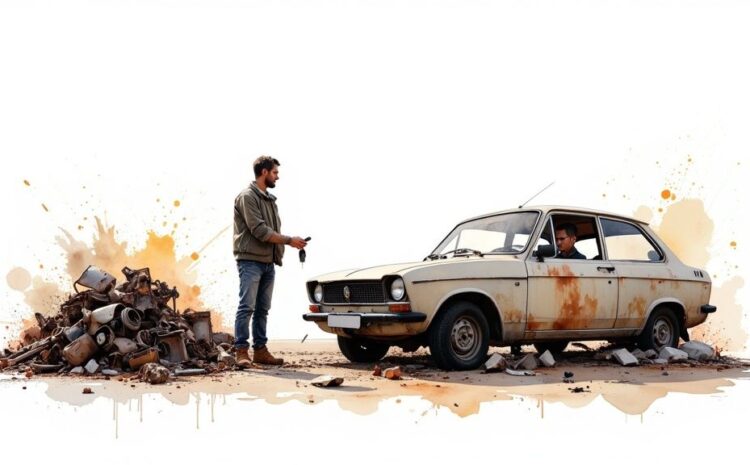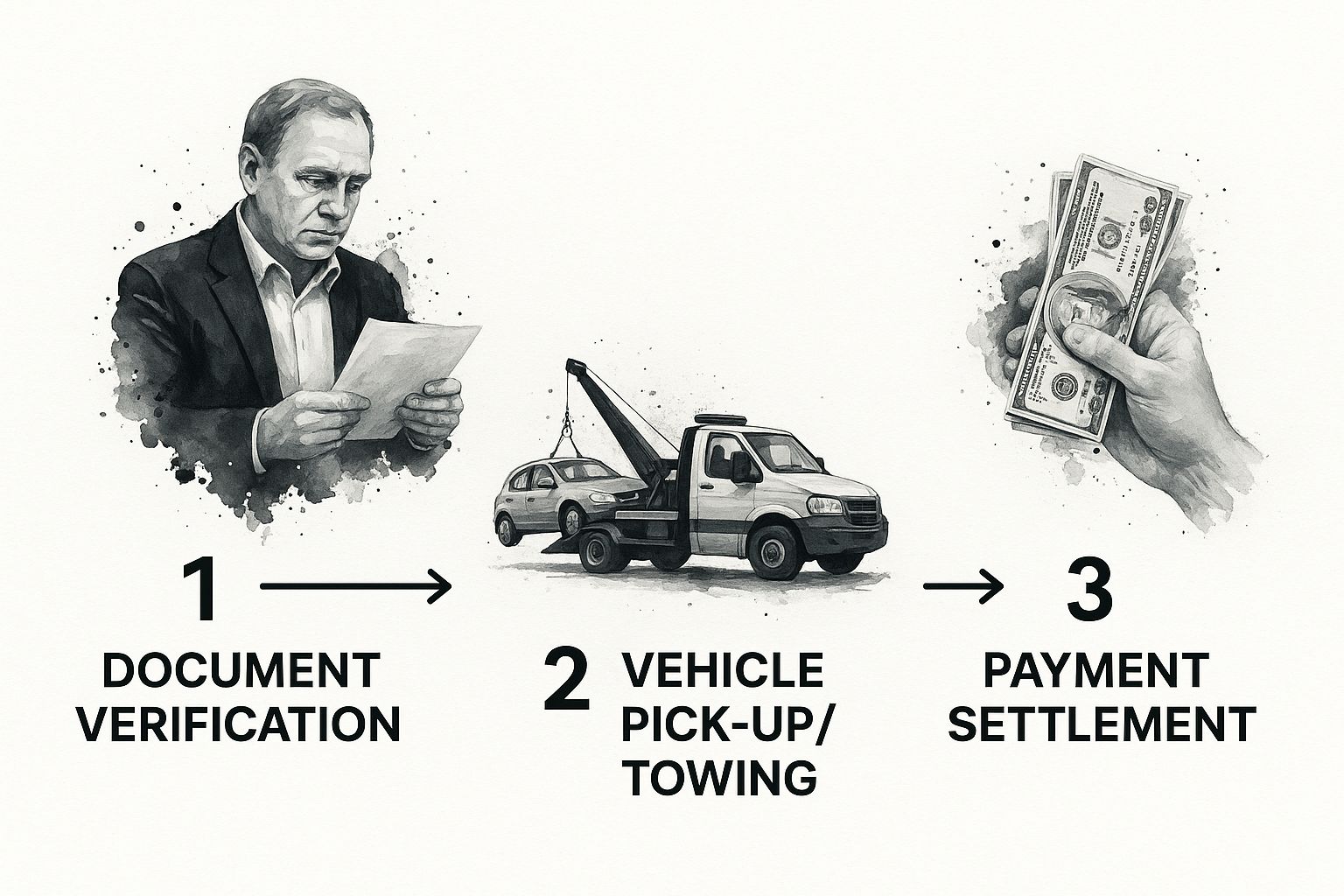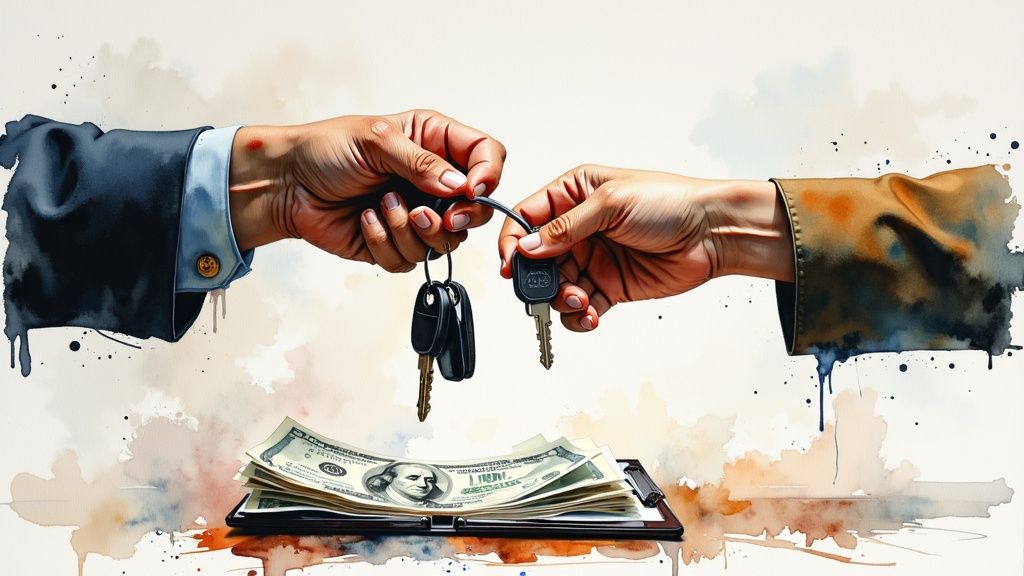
Find a Scrap Yard Near Me Car A UK Driver’s Guide
When you type "scrap yard near me car" into a search engine, you'll get a flood of results. The real challenge, though, isn't just finding a yard—it's finding a reputable one that's legally allowed to do the job. Your top priority should be locating an Authorised Treatment Facility (ATF). These are the only places in the UK legally permitted to scrap cars, and dealing with one is the only way to ensure your car is recycled properly and you get the right paperwork.
How to Find a Trusted Local Scrap Yard
So, your old car has finally given up the ghost. Your first instinct is probably to grab your phone and start searching. That’s a good start, but you need a bit of a strategy to sift through the options and find a genuinely good operator, not just the one with the biggest ad. You're looking for someone who's not just close by, but also fully licensed and upfront about their process.
Using Online Maps and Directories
Let's be honest, you're going to start with Google Maps. A quick search for "scrap yard near me car" will bring up a map dotted with local businesses. It’s a brilliant way to get your bearings.
Here is a typical search result you might see on Google Maps for local scrap yards.
This visual gives you the lay of the land, showing you locations, opening hours, and—crucially—customer reviews. Don't just glance at the star rating; take a minute to read what people are actually saying. A yard with plenty of detailed, positive reviews is usually a safe bet.
Beyond a simple map search, you can also check specialised online directories that only list ATFs. These can be a real time-saver, as they've already done the initial vetting for you.
What to Look for in a Scrap Yard
Once you've got a shortlist, it’s time to do a little more digging. A professional, trustworthy scrap yard will tick a few key boxes.
-
They Must Have an ATF Licence: This is the big one. It's non-negotiable. An ATF licence, issued by the Environment Agency, proves they have the facilities and know-how to handle and recycle your car safely. If they can't show you proof, walk away.
-
Free Collection is Standard: Any decent scrap service should offer to collect your vehicle for free, especially if you're local. If they're trying to charge you for collection, it's often a red flag.
-
They Issue a Certificate of Destruction (CoD): This document is your official proof that the car has been scrapped. Without it, you could still be legally responsible for the vehicle. You can find out more about the whole process in this guide on how to scrap your car.
You’re not just getting rid of an old car; you're taking part in a huge recycling effort. In 2024, more than 1.2 million vehicles were officially scrapped in the UK, and the country managed to reuse and recycle an impressive 86.5% of their weight. It's a massive contribution to the circular economy.
How to Get the Best Price for Your Scrap Car

Getting a great price for your old motor isn’t down to luck; it’s about understanding what gives it value and knowing how to play the game. The quote you get from a local scrap yard isn't just a figure plucked from thin air – it's based on a few key elements.
The biggest one? Your vehicle's weight. Simple as that. Scrap metal is traded by the tonne, so a hefty vehicle usually translates to a bigger payout. But remember, the market price for scrap metal changes daily, a bit like the stock market, and that directly affects what dealers will offer you.
Beyond sheer weight, the make and model of your car also matter a great deal. Certain cars are built with more valuable metals, or they might have specific parts that are still in high demand. Sometimes, these factors can be even more important than the car's overall weight.
The Secrets to a Better Scrap Offer
Here’s the golden rule: never, ever take the first offer you get. You wouldn't do it when selling a house, so don't do it with your car. The best approach is to ring around. I always recommend contacting at least three different Authorised Treatment Facilities (ATFs) to get a true sense of the going rate in your area.
To make those calls quick and efficient, have this information handy:
- Vehicle Registration: This is the easiest way for them to pull up all the specs.
- Make, Model, and Year: Crucial for identifying any parts that could be salvaged and resold.
- Its Condition: Be upfront. Is it a non-runner? Has it been in a smash? Honesty gets you an accurate quote.
- Your Location: They need your postcode to confirm they offer free collection.
Timing and the popularity of your car's model can make a real difference. While scrap prices fluctuate, popular models often fetch a better price. For example, the CarTakeBack Scrap Car Price Index noted that average prices were holding steady around £227 in early 2025. Unsurprisingly, the Ford Focus was the most scrapped car, often bringing in returns higher than the average.
What Factors Influence the Price?
The quote you receive is a calculation based on several moving parts. Here’s a quick breakdown of what scrap yards are looking at when they value your car.
Key Factors Influencing Your Scrap Car's Value
| Factor | Impact on Price | Example |
|---|---|---|
| Vehicle Weight | High. This is the primary driver of value. | A large 4×4 will be worth more than a small city car, assuming all else is equal. |
| Make & Model | Medium to High. Determines salvageable parts and metal composition. | A Ford Focus might have more in-demand parts than a less common imported model. |
| Market Fluctuations | High. The global price of steel, aluminium, and copper changes daily. | A surge in demand for steel could increase your car's value overnight. |
| Missing Parts | Medium. A car missing key components will receive a lower offer. | If the catalytic converter or engine has been removed, the quote will be reduced. |
| Location | Low to Medium. Can affect collection costs and local competition. | Quotes may be slightly higher in areas with more competing scrap yards. |
Ultimately, understanding these elements puts you in a much stronger negotiating position.
Should You Strip Parts Yourself Before Scrapping?
It's a question I hear all the time: "Can I make more money by selling the battery or catalytic converter separately?" While it sounds like a good idea in theory, it's often more trouble than it's worth.
Yes, catalytic converters have precious metals inside, but getting one off requires the right tools, a fair bit of know-how, and a safe way to lift the car. More importantly, most scrap yards will simply lower their quote if they find key components are missing. You might go through all that effort just to break even, or even lose money.
Your best bet is to sell the car complete to a reputable ATF. If you want to dive deeper into how valuations work, have a look at our guide on how much your scrappage car is worth. By arming yourself with a few quotes and a bit of knowledge, you can be confident you’re getting a fair price.
Getting Your Car Ready for Collection

So, you’ve agreed on a price and the collection is booked. Excellent. Before the tow truck arrives, it’s worth spending 15-20 minutes getting the car ready. A little bit of prep now can save you a lot of hassle later and makes sure the handover goes off without a hitch.
First things first, have a proper clear-out. Go through the car from front to back and remove every last one of your personal belongings. You'd be surprised what you can find tucked away in door pockets, under the seats, or buried in the boot.
Check the glove box, the centre console, and any other little cubbyholes. Once the car is collected, anything left inside is gone for good, as it will be crushed and recycled along with the vehicle. This is your last chance to rescue that favourite CD or those forgotten sunglasses.
What You'll Need on the Day
When the driver arrives, they'll need to confirm a few details before they can legally take your car. Having the correct documents ready to go is the key to a quick and simple handover. Forgetting something important can unfortunately grind the whole process to a halt.
Make sure you have these three things to hand:
- Photo ID: A valid driving licence or passport will do the trick. The name and address on your ID must match what’s on the V5C logbook.
- The V5C Logbook: This is the big one. It proves you're the registered keeper. You’ll need to fill in Section 9 (or Section 4 on the newer versions) with the details of the scrap yard taking the car.
- The Keys: It sounds obvious, but you’d be amazed how often they go missing at the last minute! Keep them somewhere safe and ready for the driver.
Having these items prepared shows you're the genuine owner, which is a legal must-have for any Authorised Treatment Facility (ATF). It’s a simple step that protects both you and the scrap yard from any potential fraud.
One last thing – don’t worry about the fuel in the tank. There's no need to drain it. The ATF has all the specialist equipment to deal with that safely and responsibly. Just focus on your bits and pieces and the paperwork.
Getting the DVLA Paperwork Spot On
Dealing with the official paperwork can feel like a bit of a drag, but trust me, it’s the most critical part of the whole process. If you don't let the Driver and Vehicle Licensing Agency (DVLA) know what's happening, you could be facing fines and a whole lot of hassle later on. The good news is, it's pretty simple once you know the steps.
The V5C Logbook: Your Key Document
Everything hinges on your V5C logbook, which is your vehicle's registration certificate. You’ll need to fill out a specific section with the person from the scrap yard who comes to collect your car.
- On the newer, multi-coloured logbooks, you’re looking for Section 4.
- If you have an older V5C, it’ll be Section 9.
In this section, you need to jot down the scrap yard's official name, their address, and their VAT number if they have one. Make sure you both sign it. You then tear off and keep the yellow slip (that’s your Section 4 or 9). The scrap yard will take the rest of the V5C away with the car.

It’s your job to send this slip to the DVLA. Don't rely on the scrap yard to do it for you – this is your legal responsibility.
Your Proof of Scrapping: The Certificate of Destruction
After you've sent your V5C slip off, there’s one last piece of the puzzle: the Certificate of Destruction (CoD). This isn't just a simple receipt; it's a vital legal document proving your car has been properly and permanently destroyed.
The Authorised Treatment Facility (ATF) – that's the official term for the scrap yard – is legally obliged to send you a CoD within seven days of taking your car. This certificate is your concrete proof that you're no longer the registered keeper. It absolves you of any responsibility for future fines or penalties linked to that registration number.
My advice? Keep your Certificate of Destruction somewhere safe. If the DVLA ever gets in touch about the old car, this document is your irrefutable evidence that you did everything by the book. It confirms the precise date your vehicle was officially scrapped.
This whole process is a crucial part of managing the UK's huge number of vehicles. To give you some context, as of December 2024, there were around 33.97 million cars registered in the UK. Popular models like the Vauxhall Corsa and Ford are often scrapped after an average of 14 years on the road. For more interesting stats on the UK's car market, it's worth checking out the insights on WeBuyAnyCar.com.
And if your car was already off the road, you might find our guide on what happens after you SORN your vehicle useful.
What Really Happens at the Scrap Yard
So, you’ve waved goodbye to your old car as it disappears on the back of a tow truck. Ever wonder what happens next? It’s not just a case of crushing it into a cube. Your vehicle is about to go on a surprisingly complex recycling journey at what’s known as an Authorised Treatment Facility (ATF). This is a highly regulated process designed to salvage as much as possible and protect the environment.

The first and most critical stage is depollution. Before anything else, all the hazardous fluids and materials have to be carefully and safely removed. This is a far more thorough job than just draining the petrol tank.
Here's what they'll do:
- Drain all fluids: Technicians will drain the engine oil, coolant, brake fluid, and even the windscreen washer fluid into special sealed containers for recycling or safe disposal.
- Remove the battery: The car battery is taken out straight away. This prevents nasty acid leaks and allows the lead inside to be recovered.
- Tyres and gases: The tyres are pulled off to be shredded or repurposed, and the gases from the air conditioning system are professionally extracted so they don't escape into the atmosphere.
From Spares to Shredding
Once the car is free of anything dangerous, the salvaging begins. Mechanics will go over the vehicle, looking for any parts that are still in good working order. Think alternators, wing mirrors, gearboxes, or sometimes even whole engine blocks. These components get cleaned up, tested, and sold as affordable second-hand spares, which is great for other drivers and the circular economy.
After all the good bits have been stripped away, the remaining metal shell is finally ready for the main event. It’s fed into a colossal shredder that rips the car into thousands of fist-sized chunks of metal. A system of powerful magnets and advanced sensors then gets to work, separating out the different types of metal—steel, aluminium, copper, and more. These are compacted into bales and shipped off to mills to be melted down and reborn as new products.
Got Questions About Scrapping Your Car? We've Got Answers
Even when you've got a plan, it's natural to have a few last-minute questions about scrapping your car. It’s a process most people only go through once or twice, so getting clear, honest answers is key to feeling confident and avoiding any nasty surprises. Let's run through some of the most common things people ask.
What If I Can't Find My V5C Logbook?
Don't worry, you can still scrap your car. While having the V5C makes things a bit smoother, it’s not a deal-breaker.
If your logbook has gone missing, you'll just need to show some valid photo ID instead – a driving licence or passport is perfect, as long as the address on it matches where the car is registered.
You’ll then have to let the DVLA know in writing that you’ve sold (or scrapped) the car. Make sure you include the full name and address of the scrap yard (the ATF) and the date you handed the car over. Any professional, licensed yard will be familiar with this and can point you in the right direction.
How Do I Actually Get Paid?
This is a big one. You might be picturing a wad of cash, but that’s actually illegal in the UK. The Scrap Metal Dealers Act 2013 put a stop to cash payments to crack down on metal theft and make every transaction traceable.
So, any legitimate scrap yard near me car search will lead you to a business that pays by bank transfer or cheque. If someone offers you cash, walk away. It's a huge red flag that they aren't operating legally.
The no-cash rule is your best friend when looking for a trustworthy operator. It’s there to protect everyone and ensures the whole deal is transparent and above board.
Do I Have to Be There for the Collection?
It’s definitely best if you are. Typically, you or someone you trust will need to be present when the collection driver arrives. This is so you can hand over the keys and the V5C, and they can quickly verify your ID.
Life happens, though. If you absolutely can't be there, you need to talk to the scrap company about it when you're making the booking. Some might have a workaround, but it’s something you must arrange in advance to prevent any mix-ups on collection day.
Ready to get a fair, transparent price for your old vehicle? Fast Scrap Car offers a hassle-free service with free collection across London and Surrey. Get your instant quote and see how easy it can be.
